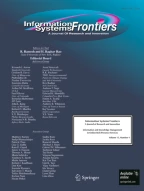Abstract
Data mining has, in the past, tended to use simplistic statistical methods (or even none at all). In this paper we show by example how cutting edge (but easy to use and comprehend) statistical methods can yield substantial gains in data mining. The role of statistics in IS/IT (information systems and information technology) in general can be substantial, yielding more nearly optimal performance of problems at the emerging frontiers in all their aspects.
Similar content being viewed by others
References
Carbonell JR, Elkind J, Nickerson R. On the psychological importance of time in a time sharing system. Human Factors 1968;10(2):135–142.
Dudewicz EJ, Karian ZA. The Extended Generalized Lambda Distribution (EGLD) system for fitting distributions to data with moments, II: Tables. American Journal of Mathematical and Management Sciences 1996;16(3 & 4):271–332.
Karian ZA, Dudewicz EJ. Modern Statistical, Systems, And GPSS Simulation (Second Edition). Boca Raton, Florida, London, New York, and Washington, D.C.: CRC Press LLC, 1999.
Karien ZA, Dudewicz EJ. Fitting Statistical Distributions to Data: The Generalized Lambda Distribution (GLD) and the Generalized Bootstrap (GB) Methods. Boca Raton, Florida, New York, and Washington, D.C.: CRC Press LLC, 2000.
Karian ZA, Dudewicz EJ, McDonald P. The Extended Generalized Lambda Distribution system for fitting distributions to data: History, completion of theory, tables, applications, the ``final word” on moment fits. Communications in Statistics-Simulation and Computation 1996;25(3):611–642.
Mamrak SA, Amer PD. Computer Sciences & Technology: A Methodology For The Selection Of Interactive Computer Services. National Bureau of Standards Special Publication,No. 500–44. U.S. Government Printing Office, Washington, D.C.20402, 1979;500–544.
Author information
Authors and Affiliations
Rights and permissions
About this article
Cite this article
Dudewicz, E.J., Karian, Z.A. The Role of Statistics in IS/IT: Practical Gains from Mined Data. Information Systems Frontiers 1, 259–266 (1999). https://doi.org/10.1023/A:1010002428579
Issue Date:
DOI: https://doi.org/10.1023/A:1010002428579
